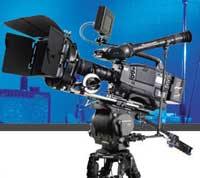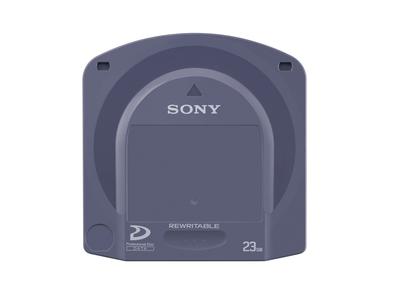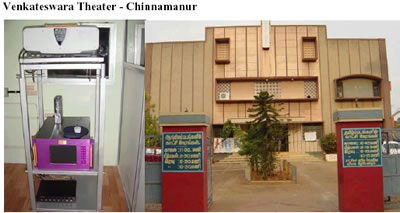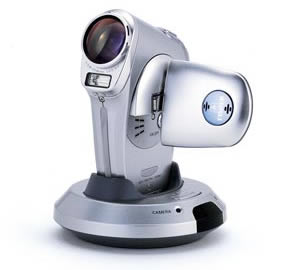
| Video Technology Magazine | October 2004 |
I have been contacted by several readers and started to see a flood of discussion about download-able TV, cable boxes. Several even want me to work on these.
It's disturbing really since I was talking about this back in 1996 and talking to the now dead Intertainer back in late 1997 about this as well as approached much of the adult industry , Penthouse, Vivid etc about it. Even briefly with a group USVI, US Video Interactive.
Even companies like the now defunct LOADtv were doing this 5 years ago.
I guess things like Akimbo and MovieBeam are finally starting to sink into investors heads! Not only can we do standard Def, but live HDTV and Digital Cinema already using P2P over $50 a month DSL lines and Cablemodems. How much farther past the flashpoint will we need to go before this technology starts to ignite. The longer it takes the harder it will explode when it does eventually happens. Below are some blogs and article I am starting to see on this.
washingtonpost.com - Web TV Start-Ups Show Programs Outside the Box
Ripped from Blogs Fred Wilson writes about a discussion on "about Video On Demand (VOD), TV delivered over phone lines (IP TV), Video on the Internet (Streaming), and Downloadable Video (Bit Torrent)":
I believe we are going the way of downloaded TV over the long run. What should the content owners do about this? I think they should recognize that the ad sponsored content model can work in a downloaded world. They should cut ad avails into their programming, hard wire an IP address into those ad avails to pull an advertisement off of their servers, and then let the programming go wherever it will go. In an always on world, they'll get the ad impressions they always got, and probably a lot more.
[Via Fred] - TV Harmony argues for Video-on-demand:
for a large percentage of the population, VOD, especially if it expands to becoming a centralized DVR, is likely going to be the easier solution.
video's relationship with people [is] different than the relationship people have with music. People listen to music over and over again, but in general, video is a single use commodity for the most part. This changes the calculus slightly in that the pain to download a video has to be less than the pain to download a music track, or it doesn't seem worth it. content providers have an excellent opportunity to create their own services before the suffer a napster-like meltdown.
There is a huge market for P2P Video Streaming over Internet. At an average streaming bandwidth of 256-384kbps, the quality is *fair* enough to watch on a 15" monitor (not full size).
NOTE: Anyone wanting to compete with BitTorrent or do peer2peer should check out my(John Sokol's) ECIP Protocol and contact me first.
(from SlashDot)
HD DVD spec advances, products expected in 2005 EETimes, June 18, 2004
It is already possible using H.264 or WM9 to stream HDTV at around 1Mbps. This level of bandwidth is awailable to cable modem and high end DSL customers. See Akimbo
"Media Center PC as the entertainment hub in your home, the Media Center Extender extends the powerful features and storage capabilities of the Media Center PC to any room in the house." You must have a Media Center PC running Windows XP Media Center Edition 2005 to operate the Media Center Extende r Although Media Center Edition 2005 will be able to record and playback HDTV the extender will only be able to do Standard Def and not HD.
 It's really a high end camcorer that shoots on DVCPRO HD Media, with 16:9 720p HD resolution. I don't know if I'd consider 720p to be worthy of the title digital Cinema, it's sort of like shooting with 16mm film. Most Digital Cinema being setup with 2K systems with just slightly over 1080p/24 image sources (this is what George Lucas shot the new StarWars movies in). None the less it's a really cool camera. AJ-HDC27V can be rented from Bexel Corporation (Burbank, CA). Panasonic Sells the AJ-HDC27F for $66,000 US they also have the AK-HC931 for around $49,000 US and the AK-HC900 for $29,000 US. Link here
These movies are equipt with the latest in DRM (Digital Rights Management) that only allow a 24 Hr viewing period before becoming deactivated. The market research company, NPD Group measured consumer activity for the first 6 months of 2004. The activity at present is modest with paid movie downloads accounting for just 0.3% of video units that were purchased or rented. MovieLink accounted for 33% of all sales followed by MovieFlix with 13%. The demographics are interesting in that they mirror in many ways the demographics of the early paid music download sites. NPD Group found that 80% of users are males and that one out of four between are between the ages of 18 and 24. Half of download renter are presently under age 35 and 80% are under age 45.
Paid Movie Downloads Follow Digital Music's Lead
VOD Streaming and Download movie service providers are:
Full Movie Downloads (can anyone try this one and tell me what the deal is? Mail me) I have seen several sites posing as legitmate services and are really some P2P File Sharing like Kazaa or Gnutella behind it.

They only store 23.3 GB, It's like $3,000 US for the drives and $50 to $60 per disk. This only 5x the capacity of regular DVD-R 4.7 Gig Disks that are under a as low a $0.43 USD already. There is also 9.4GB Double Sided DVD-R disks for around $3 a disk.
These days it's DVD's and the player it self generates these signals. They distort the video even under the best of circumstances. Even when playing a DVD on my ATI Radeon 9800 with TV out it generates these MacroVision distortions that effect my image quality, this also happens when playing downloadable movies! Fortunately thing like the BT878 Capture board aren't affected by it, so programs like vesatv remove it. And many companies sell "video stabilizers" or "signal cleaners" that repair the video sync to be NTSC compliant again. Sima sells the CT-1 for $89 that will do this. General Macrovision-free Tips from [digital-digest]
The novelty is specially aimed at future mobiles with VGA screens that will be less than 2.4 inches. It generates color using an entirely new driving method called sub-pixel unit driving methodology. Contrary to existing color display methods that express color pixel by pixel, this new method creates color at the sub-pixel level representing more than two data lines from the same pixel. By composing a new pixel with the sub-pixel on the adjacent scanning line, 480x640 (VGA) resolution can be attained from a 240x640 (half VGA) panel. The device can display up to 260K colors for TFT panels in mobile phones. Additionally, the problem of dark screen due to the increased pixel density on high resolution panels has been solved using 4-color (R-G-B-W) rendering algorithm, improving the brightness of TFT-LCD panels. With this 4-color rendering algorithm, which extracts white signal from R-G-B signal input and processes 4-color R-G-B-W, the brightness of panel is increased more than 50 percent. "Development of high-resolution displays is urgently needed with the advent of camera phones, video phones, TV phones and other new products that require an entirely different level of image quality," said Dr. Jin-tae Kim, vice president of System LSI Division at Samsung Electronics. "The 4-color sub-pixel rendering technology we recently developed will play a key role in the transition to ultra-high-resolution panels for mobile products. Moreover, our development of this new chip will put us in an advantageous position in the hotly-contested market for mobile size displays." Samsung Electronics plans to begin using the technology on high-end mobile phone models in the second quarter of 2005.
|
AMC will present the film digitally, using AMC's proprietary Digital Theatre Distribution System (DTDS).
National Cinema Network offers integrated cinema media (film, slide and audio advertising), lobby marketing, and Internet opportunities that reach moviegoers everywhere they go. Founded in 1985, National Cinema Network has developed several cinema advertising innovations, successfully introducing new advertising and promotion platforms in theatres, while respecting and maintaining the entertaining environment. National Cinema Network continues its commitment to innovation and quality with the introduction of a digital management system, DTDS(.), an easy-to-use management tool for scheduling, distributing, controlling, and reporting content displayed within a movie theatre. Based in Kansas City, Mo., the company represents top theatres in top markets including 51 of the nation's top 100 highest-grossing theatres. www.ncninc.com.
Last month AMC experimented with feature-length programming by releasing the independent film Evergreen to its theatres by satellite. The movie industry, which still hasn't arrived at standards for digital movie distribution -- and is worried about digital piracy and who will pay for the expensive equipment in theatres -- is closely watching the move. The AMC System isn't compatible with the standards set by DCI, the seven-studio digital cinema coalition.
"It's a problem that there are inferior quality systems that are going to be used to show movies to moviegoers," Doug Darrow, business manager DLP Cinema, is quoted as saying.
Currently National Cinema Network pre-show advertizements NTSC, 720 x 480, Digital Betacam (DigiBeta), 16:9 Letterbox - 16:9 Anamorphic
"The concern with these experiments with less than 2K (resolution) is you start to chip away at the idea of a single global system, and the whole thing could dissolve into some chaos of standards," said Charles Swartz, executive director and CEO of the Entertainment Technology Center at USC. "We may lose the opportunity to get to the single inventory system." hollywoodreporter AMC Entertainment, the second largest cinema chain in the United States with more than 3,500 screens, is using its technology to bring the movies to a small number of its theatres. Back in July AMC was acquired by Marquee Holdings Inc., an investment vehicle owned by JPMorgan Partners ("JPMP"), the private equity arm of J.P. Morgan Chase & Co. (NYSE: JPM), and Apollo Management, L.P. ("Apollo"), a private investment firm. I can help but wonder of this move away from the DCI system with Lyons Gates had anything to do with the acquisition? AMC representative Rick King said the equipment used by AMC is much less costly than the $130,000 to $150,000 US per screen estimate for theatre installation once standards have been arrived at. Lions Gate to use satellite distribution system
TOKYO (AFX) - Firms that are supporting one of the next-generation optical DVD formats, the Blu-ray Disc, plan to release camcorders that record on smaller versions of the discs as early as 2005, the Nihon Keizai Shimbun reported, without citing sources. Sony Corp, Matsushita Electric Industrial Co Ltd and Sharp Corp plan to develop smaller, 8-cm discs for recording, that are 4 cms smaller than current Blue-ray discs, the report said. The firms also plan to introduce camcorders that use these smaller discs, which will have a capacity of about 15GB, 40 pct less than standard Blue-ray discs, with prices about triple the price of normal camcorders, the report said. Firms backing the Blu-ray format have been competing with the other next-generation DVD format, HD-DVD, which is supported by such companies as NEC Corp and Toshiba Corp.
I don't know if I agree with the article below but it's worth the read.
Toshiba will release laptops with HD-DVD under its high-end Qosmio brand and plans to ship one million units in the first year to Europe, the U.S. and China, as well as Japan. The company claims the slimline HD-DVD format is more suitable to laptop PCs than the rival Blu-ray Disc format.
Mukta Adlabs will take care of the digital conversion of the southern movies as part of the operational partnership with Kalasa. The JV will also supply e-cinema audio interface systems and provide maintenance support to Kalasa. Singapore-headquartered GDC Technology will provide the digital servers. Kalasa, which launched its digital cinema initiative in June, plans to double its digital cinema installations to 10 in Tamil Nadu within a month. The company expects to install 65 theaters and release about 30 films in digital format in its first year of operations. "Machie", starring Dushyanth, was the first film to be released in August as part of a "digital cinema initiative for south India", launched by Kalasa. Kalasa managing director Ramesh V. Subramaniam says as many as 250 digitizing projects, which will help cut production costs and combat video piracy, have already been completed. Kalasa has received $ 0.5 million from Sat Pal Khattar, a founding partner of Singapore-based law firm Khattar Wong and Partners. "We are expecting another $ 2.5 million from foreign investors in the next two months," says Kalasa CEO Ramesh V Subramaniam. Indian venture capitalists from Mumbai and Bangalore have also showed interest in investing in digital cinema, he adds. 
One of the theatres in Tamil Nadu where Kalasa has installed digital cinema system Kalasa prefers 'A2' class theatres (which fall between A and B class theatres) in South India, while Mukta Adlabs has been targeting the 'B' and 'C' class theatres in other parts of the country for a digital cinema roll out. "Ticket rates in the A2 theatres range between Rs 15 - Rs 25 ( 32¢ to 54¢ cents US) while in 'A' class theatres it is between Rs 25 - Rs 40.( 54¢ to 87¢ cents US) We are not targeting theatres in the 'C' category as ticket rates in such centers are very low. Recovering costs take a longer time," says Subramaniam. Kalasa, set up in early 1998, has been specializing on all aspects of film sound recording and audio post-production. The company was restructured in April 2004 as it got into distribution of movies in the digital format.
Related Stories:

More info here
MythTV.info Cool site for Linux PVR's EETIMES June 08, 2000 , Battle over DTV standards goes global
The new networks are expected to offer 24 frames per second (fps) video streams with full audio support. Content will presumably be the same as conventional television broadcasts, simply on another frequency. Later additions may include pay-per-view and other on-demand and metered services. Eventually TI hopes that "mobile phone TV will do for mobile phones what HDTV did for home TVs". The chip is still a ways off, however. TI expects samples of the chip to be available in 2006, with commercial deployment in 2007. Field trials with early test equipment are already in progress, however. |
|||||||||||||||||||||||||||
Copyright © 2004, John L. Sokol
|
|

